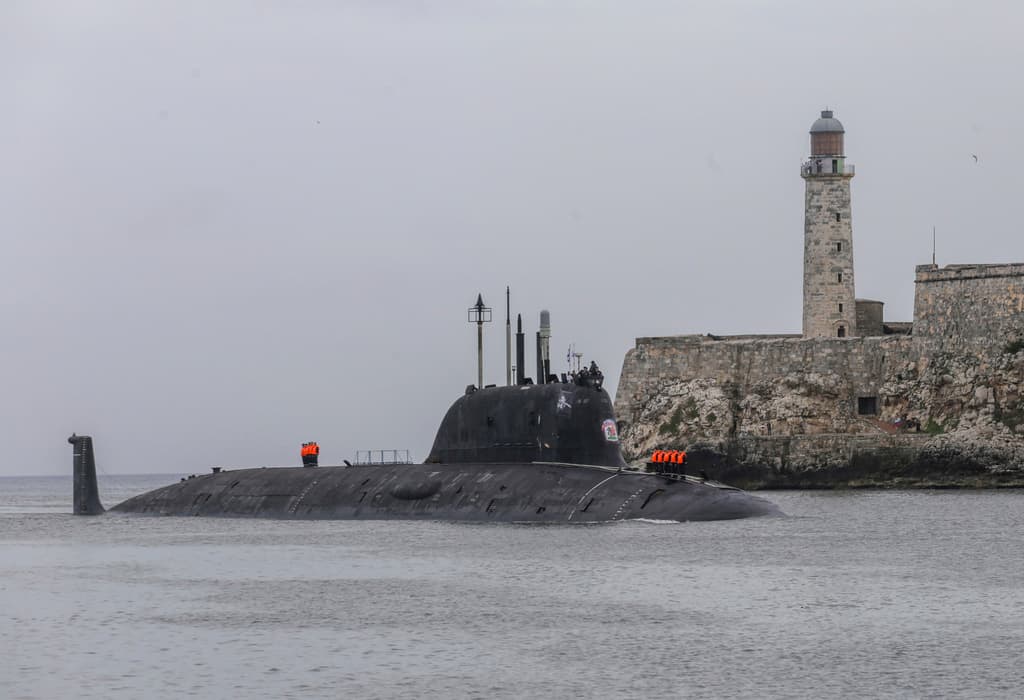America Deploys Sub-Hunting Planes Off Florida Coast as Russian Nuclear Sub, Warships Arrive at Havana Harbor
The vessels conducted ‘high-precision missile weapons’ training in the Atlantic Ocean, Russia’s defense ministry says.

The American military has deployed airplane and “submarine hunters,” the U.S. Northern Command says, to monitor the Russian nuclear submarine and other vessels that skirted the coast of South Florida and pulled into Havana harbor on Wednesday morning.
The vessels had conducted “high-precision missile weapons” training in the Atlantic Ocean, Russia’s defense ministry said Wednesday. A video released by the Russian Ministry of Defense shows rockets shooting out of the ocean and soaring high into the sky just 66 miles off the coast of Florida.
The Admiral Gorshkov frigate and the nuclear-powered submarine Kazan carry Zircon hypersonic missiles, Kalibr cruise missiles, and Onyx anti-ship missiles, the ministry said. The ships, accompanied by a tugboat and fuel ship, were welcomed on Wednesday with cannon fire from the harbor of Cuba, a longtime Russian ally. America’s Naval Destroyers tailed the Russian ships on their way to Havana’s port.
The scene is eerily reminiscent of the lead-up to the Cuban Missile Crisis in 1962, though U.S. officials say the Russian ships do not pose any threat. The U.S. Northern Command has reportedly been monitoring the Russian vessels entering the Atlantic Ocean and says that none of them are carrying nuclear weapons.
“We have seen this kind of thing before and we expect to see this kind of thing again, and I’m not going to read into it any particular motives,” the White House’s national security adviser, Jake Sullivan, told reporters on Wednesday.
Russian press reported that military drills are intimidation efforts, “giving the US a taste of its own medicine.” More than 50 ships from 20 NATO allies are currently performing major exercises in the Baltic Sea as part of the annual military exercises. Russia last month said the nuclear drills ordered by President Putin are in response to “provocative statements and threats by certain Western officials against the Russian Federation.”
The Kremlin announced on Wednesday that soldiers from its Leningrad Military District, which covers almost all of Russia’s European border from the Arctic Ocean down to the Black Sea, took part in drills to deploy tactical nuclear weapons. Those drills took place in an expanded geography bordering NATO members Norway, Finland, Poland, Estonia, Latvia, and Lithuania.
Mr. Putin’s recent military escalations do not match his promises for non-proliferation. “There is no such need” to use nuclear weapons to secure victory in Ukraine, he said on Friday, signaling that the war will not go nuclear. Yet the president did not exclude the possibility of changing Russia’s nuclear doctrine, under which he says “the use is possible in an exceptional case — in the event of a threat to the sovereignty and territorial integrity of the country.”
Russia and America have roughly 88 percent of the world’s nuclear weapons, according to the Federation of American Scientists. Mr. Putin said last week that many of Russia’s tactical nuclear weapons have 70 to 75 kilotons of explosive power, which is around five times the size of the nuclear bomb America dropped on Hiroshima in August of 1945.

